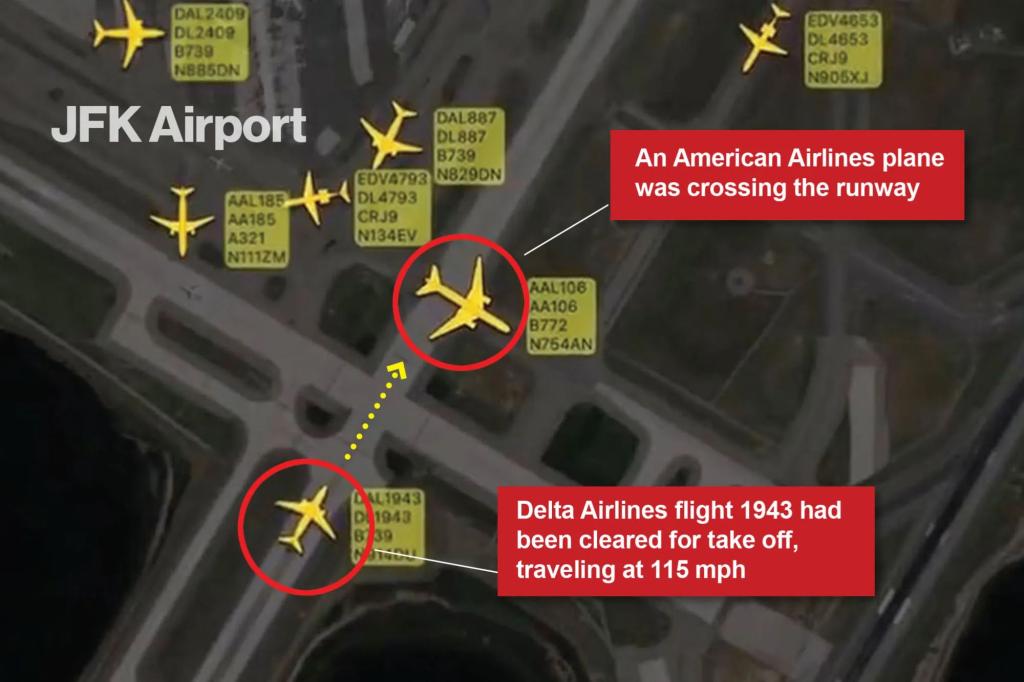The pilots of an American Airlines plane crossed the wrong runway last year in New York — into the path of another plane that was taking off — after the captain became distracted and confused about takeoff instructions and the co-pilots lost track of their plane’s location, according to documents released Monday.
Disaster was averted because air traffic controllers — using profanity — yelled at the pilots of the other plane, a Delta Air Lines flight, to abort their takeoff.
The National Transportation Safety Board released documents related to its investigation into the January 13, 2023 incident at John F. Kennedy International Airport. The investigation is ongoing, and the board said it has not yet determined the possible cause of the close call.
The nighttime incident was among several close calls at US airports that alarmed the public and lawmakers and prompted the Federal Aviation Administration to hold a “security summit” last year.
The pilot of an American Airlines Boeing 777 to London made a wrong turn on the taxiway along two perpendicular runways. The crew had originally planned to take off from runway 31L. However, they then received instructions from the controller and a message on their cockpit computer telling them to taxi across 31L and take off from runway 4L.
This diagram shows Delta Flight 1943 on a collision course with American Airlines Flight 106 at JFK Airport on Friday. FlightRadar24 An air traffic controller hurled abuse before ordering Delta Flight 1943 to abort takeoff. FlightRadar24 This image shows an American Airlines flight crossing onto a Delta runway from an adjacent taxiway. FlightRadar24
In later interviews, “all three pilots (on the American Airlines plane) said they understood at the time that (the flight) was going to take off from runway 4L,” according to the NTSB.
Instead, they cross 4L just as a Delta Boeing 737 begins takeoff on the same runway.
The captain, Michael Graber, said as the plane crossed the center of runway 4L, he saw a red runway light come on — the light that warns pilots when it’s unsafe to be on the runway.
“All of a sudden I saw that red light and I just – immediately I said something – that’s not right,” he told investigators. “I don’t know what happened, but I think something is wrong.”
Captain added power to accelerate across.
Graber told investigators that he heard and understood the instructions from the controller but was distracted by the heavy workload and, in his mind, may have reverted to thinking they were taking off from another runway.
The co-pilot, Traci Gonzalez, said she knew all along that they were supposed to cross runway 31L, “but she was unaware of the aircraft’s position when the captain taxied onto runway 4L,” investigators wrote. “He knew they were approaching runway, but he didn’t realize they were approaching runway 4L.”
Follow today’s most important news
Stay up to date with the Evening Update.
Thank you for signing up!
The co-pilot also blamed interference, including an unusually high number of weather warnings.
A third person in the cockpit, Jeffrey Wagner, the co-pilot for the long international flight, said he was “heading down” and had no idea where the plane was as it taxied onto the runway. He said when they crossed the wrong runway and he saw a plane to his right, he initially thought it might be driving behind them.
Delta pilots, alerted by air traffic controllers, were able to brake to a stop. The planes were never closer than about 1,000 feet (300 meters) — not a comfortable margin in terms of aviation safety.
A controller warned the American crew of “possible pilot malpractice,” and gave them a phone number to call, which the captain did. After a delay, they took off for London — this time on runway 31L. The crew did not report the incident to American Airlines prior to takeoff.
Cockpit voice recordings from inside the American plane were recorded during the six-hour flight to London and are lost forever.
Investigators said they tried several times to interview the American pilots, but the pilots refused on the advice of their union, which objected to the NTSB recording the interviews. The NTSB then took the highly unusual step of issuing a subpoena to compel the crew to sit for taped interviews.
The pilots’ union, the Associated Pilots Association, had no immediate comment Monday on the NTSB document.
The report renewed the recommendation that the Federal Aviation Administration require better preservation of cockpit voice recordings. They run on a loop that usually records on long sounds after two hours. The FAA finally bowed to NTSB pressure late last year, announcing that it would recommend that 25 hours of recordings not be overwritten — but only on new aircraft.
Categories: Trending
Source: thtrangdai.edu.vn/en/



